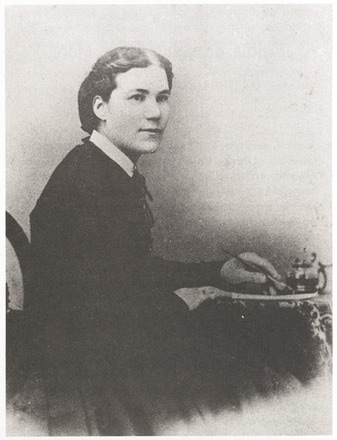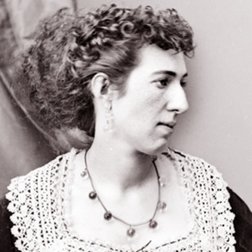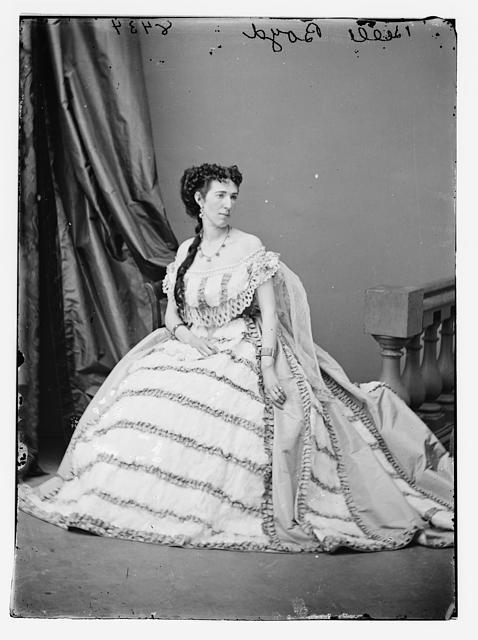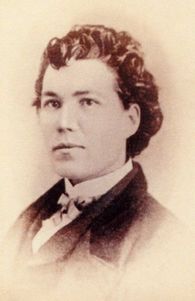Intelligence Report--Behind Rebel Lines: The Incredible Story of Emma Edmonds, Civil War Spy3/30/2017
As an action hero, Sarah Emma Edmonds is the Lara Croft of the Civil War. Assuming the identity of the male soldier Franklin “Frank” Thompson, she joined the Union Army in 1861 as a battlefield nurse, and spent time as a courier before taking on the role of Union spy. If young women of your acquaintance need a historical role model, they could certainly do worse than Sarah Emma Edmonds.
Behind Rebel Lines has been on my reading list for longer than Civil War Scout has existed. I have been anticipating this fictionalized version of Edmonds’ story, but in the end, it didn’t live up to my (perhaps too lofty) expectations. At just under 150 pages, this is a relatively short book, and as such, it doesn’t provide more than a few pages of context to explain Edmonds’ adopting a male persona even before her time in the Union Army. This results in a rather flat character who is driven by vague, unspecified motivations usually attributed to an “imp voice”. Unfortunately, this motivation is confusing for several reasons:
This book was originally written in 1991 and has been republished several times. The language and stereotypes may be a bit jarring, especially when Edmonds takes on the personas and dress of others as she is inserts herself in her spy career, but I suspect that much of that comes directly from her memoirs and is indicative of the contemporary accounts during the Civil War. Though it is on my (extensive) reading list, I have yet to read Edmonds’ memoirs Nurse and Spy in the Union Army, so I can’t judge how faithfully the narrative follows the original memoirs, but I can confirm that the soldier Allen Hall, whom Edmonds discovered on one of her espionage missions, does show up on the muster rolls of the 25th Virginia Infantry which fought at Gaines Mill (also known as the First Battle of Cold Harbor), so it does lead credence to the veracity of the story. Until I have a chance to read the source documentation (or what the author claims as his source documentation), I will categorize this as historical fiction. A great companion to this book is the History Channel’s Full Metal Corset: Secret Soldiers of the Civil War which introduces Edmonds with more background and fleshes out her personality and her history.
1 Comment
Unlike many of the families in the area of Virginia the Boyds lived (which was so against secession that it broke from Virginia to create the Union-loyal state of West Virginia), the Boyds had deep southern roots and supported the cause of the Confederacy. Belle’s father volunteered for a Virginia infantry regiment which was commanded by Colonel Thomas Jackson before he had earned his famous nickname for standing like a stone wall. After a skirmish between Confederate and Union forces at the Battle of Falling Waters, just 8 1/2 miles north of the Boyds’ home, Union forces came through Martinsburg. One of the Federal soldiers entered the Boyd home and confronted Belle’s mother. Belle would not tolerate the disrespectful and harassing language and behavior. She shot the man. The Union officer sent to investigate determined that Belle had been in the right and she escaped punishment. Belle was not considered beautiful, but because she was tall, vivacious, well-dressed and young, she was able to charm unsuspecting Union officers into revealing information which she would then pass to the Confederates through her neighbor or her slave. Eventually, she became an official operative for Generals PGT Beauregard and Stonewall Jackson. In May 1862, after having been detained by Union forces, she was at her aunt’s home near Fort Royal. The home was now the headquarters of Union General James Shields, who was on a mission to whip Stonewall Jackson in the Shenandoah Valley. The General called a Council of War--a meeting with his subordinates to set a course of action--held in her aunt’s drawing room. On the second floor, directly above the drawing room was a closet. And in the floor of the closet was a hole. Belle gathered her intelligence while in the cramped closet, then when the Council ended at 1 a.m., she set out for Confederate lines on horseback, her pockets holding cast off passes for Confederate heading south. The papers fooled the sentries, and she was able to get her information to Confederate cavalryman Colonel Turner Ashby. On May 23rd, Jackson’s men approached Front Royal. Belle had more valuable information that she believed could ensure a victory for the Confederate forces. She knew the size and disposition of Union forces in the lower (northern) Shenandoah Valley. Though she approached several men who had professed Confederate sympathies to carry the information to Jackson, none agreed to do so. So she went herself. Belle’s escape from the Union lines was harrowing, with Federal picket fire hitting the ground near enough to spray dirt in her eyes and other Union bullets tearing holes in her dress. When she was safely behind Confederate lines she was greeted by Jackson’s aide Henry Kyd Douglass who recognized her and took her notes to Jackson himself. Jackson was so grateful for her daring that he wrote her a note of thanks: May 23d 1862 Miss Belle Boyd, I thank you for myself and for the army, for the immense service that you have rendered your country today. Hastily I am your friend, T.J. Jackson, O.S.A Only two months later, Belle was captured and imprisoned at Old Capitol Prison on Washington, D.C. She spent a month there before being exchanged. She went back to her career in espionage and again, she was capture and imprisoned, this time for five months. After her release the second time, she was banished to the south, but instead of retiring, she simply decided on a change of base, and set sail for England. While enroute, her ship was stopped by the Union navy and again, she was arrested as a spy. Belle went on to captivate one of her Union captors, Samuel Hardinge, who she hoped to convert to the Confederate cause. Whether his loyalty to his country was compromised or simply his heart, he did serve time for giving aide to Belle.
References and Further Reading
Maria "Belle" Boyd Belle Boyd Biography Belle Boyd in Camp and Prison by Belle Boyd  Sarah Emma Edmonds Sarah Emma Edmonds When you think of a Civil War soldier, what image comes to mind? Perhaps a young man, thin and haggard, wearing tattered butternut. Maybe a middle aged African American soldier wearing blue for the United States Colored Troops (USCT). Maybe you think about a little boy, wearing a drum across his small body or a bugle over his shoulder. No matter what image pops into your mind, chances are the soldier you are picturing is male. According to the Civil War Trust, over 3 million soldiers fought during the Civil War and the vast majority of those soldiers were men as neither the Union nor Confederate army had a policy allowing the enlistment of female soldiers. But as many as 400 women fought regardless, serving in Union and Confederate uniforms during the war. One of those dressed in Union blue, Sarah Emma Edmonds, left behind a memoir detailing her history, and though historians are skeptical of some of her claims, what is verified fact about her life shows a woman not content to sit on the sidelines while her adopted country fought its defining war. Sarah Emma Edmonds was an American by choice. She was born in the province of Nova Scotia, Canada in December in 1841. Her father was disappointed she was not a boy, and she spent much of her young life trying to prove to him her worth. Eventually, seeing the futility of her efforts, she fled from her father’s oppression and an arranged marriage, first to New Brunswick, and later, to put more distance between herself and her father, she immigrated to the United States. She did so in disguise, adopting the persona of a young man named Franklin Thompson. She had established herself as a traveling Bible and bookseller, first in Connecticut, and later outside of Flint, Michigan where she was living when the Confederates opened fire on Fort Sumter and President Lincoln issued his call for 75,000 troops to suppress the rebellion. Edmonds decided it was time to fight for her new country.
She disguised herself as black male “contraband” named “Cuff” performing manual labor for the Confederate army.
She drew on her experience as a traveling book seller to pose as an Irish peddler woman named “Bridget O’Shea” selling goods to Confederate soldiers behind enemy lines. She donned black face and a red bandanna and while working as a washer woman, came across a packet of official papers that had been in a Confederate officers’ uniform jacket. Her unit was transferred several times, and it eventually ended up in the western theater, where Edmonds continued her work as a spy, and then as a nurse. It was here, while she was tending wounded and ill soldiers, that she contracted malaria in 1863. Afraid her secret would be discovered if she were treated by the army surgeons, she requested a furlough. When it was denied, she left her unit for treatment. Franklin Thompson was declared a deserter and Edmonds’ military career was at an end. Even while the war still raged, she wrote her memoirs titled Nurse and Spy in the Union Army, the first edition of which was published in 1864. She donated the money she earned from book sales to various soldiers’ causes. When the 2nd Michigan held a reunion in 1876, her former comrades in arms welcomed her warmly and took up the cause of removing the blight of “desertion” from Franklin Thompson’s military record, which led to Edmonds being able to receive a military pension in 1884. In 1897, she joined the Grand Army of the Republic, the fraternal organization of Union Civil War veterans. She was the only woman ever to do so. After the war, Edmonds married and had three children. She moved to Texas with her family and died in 1898. She was buried with military honors in Washington Cemetery in Houston. References and Further Reading Sarah Emma Edmonds, Private Sarah Emma Edmonds Biography Memoirs of a Soldier, Nurse and Spy: A Woman’s Adventure in the Union Army by Sarah Emma Edmonds |
AuthorToni is a wife, mom and history buff who loves bringing the Civil War to life for family members of all ages. Archives
July 2018
Categories
All
|




 RSS Feed
RSS Feed